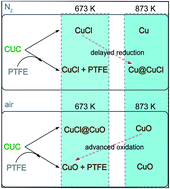Contribution of polytetrafluoroethylene to the atmosphere-dependent synthesis of Cu-based nanomaterials through ion–dipole interactions†
Abstract
A simple, but efficient, method for the preparation of a series of Cu-based nanomaterials including Cu, CuCl, CuO, Cu@CuCl and CuCl@CuO was developed. Initially, we prepared a novel precursor consisting of a Cu(II)–urea complex (CUC, a coordination compound) and polytetrafluoroethylene (PTFE, a water-insoluble polymer) using the technique of solid–solid grinding. Subsequently, the Cu-based materials were synthesized by sintering the precursor at different atmospheres and temperatures. This approach provides an environmentally friendly and green alternative towards creating Cu-based materials by generating complex–polymer binary systems without the use of solvents. Our results indicated that the effect of PTFE played a crucial role in the formation of the materials. Further, the role of PTFE was found to be associated with sintering atmospheres: the reduction of CuCl to Cu in nitrogen was delayed; contrarily its oxidation to CuO in air was advanced. The nature of this role was ascribed to an ion–dipole interaction between the partial negative charges on the fluorine atoms (Fδ−) on the PTFE chains and the Cu(II) ions in the coordination centers [Cu(II)–urea] induced by a solid–solid mixing process, leading to the CUC complex decomposing later in nitrogen and earlier in air. Also, the presence of CUC drastically affects the thermal pyrolysis pattern of PTFE, resulting in a remarkable decrease, and even disappearance of the etching signals of PTFE. Finally, our data suggested that the as-prepared Cu@CuCl nanomaterial induced a strong surface-enhanced Raman scattering effect for several model compounds, including rhodamine 6G and crystal violet. We believe that this study represents a significant step towards the development of practical synthesis of Cu-based nanomaterials and opens up exciting opportunities for the design and construction of a wide range of transition metal-based nanomaterials through the link between polymers and coordination compounds.


 Please wait while we load your content...
Please wait while we load your content...